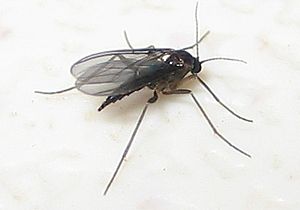Gnat facts for kids

A gnat is a common name for many different kinds of tiny flies. These little insects are usually quite small, often no bigger than a few grains of salt! They belong to a group of flies called Nematocera, which means "thread-horned" because many of them have long, thin antennae.
What are Gnats?
The word "gnat" isn't a scientific term. Instead, it's a general way to describe many small, flying insects that look similar. Think of it like calling all small, furry pets "kitties" – it's not their exact scientific name, but everyone knows what you mean! Gnats can be found all over the world.
Biting and Non-Biting Gnats
Some gnats can bite, and some cannot. The ones that bite are often called midges. They can be quite annoying, especially in damp places. Other gnats don't bite at all. They might just fly around you, especially near lights or damp areas.
Eye Gnats
One interesting type of gnat is called an eye gnat. These tiny flies are not interested in biting you. Instead, they are attracted to the moisture and fluids around your eyes. They are harmless but can be a bit of a nuisance when they fly close to your face. The Smithsonian Institution describes them as "non-biting flies, no bigger than a few grains of salt, ... attracted to fluids secreted by your eyes."
Where Do Gnats Live?
Gnats love damp places. You might see them flying in large groups, sometimes called "clouds" or "swarms," especially in areas with lots of moisture. This could be near lakes, rivers, swamps, or even in your garden after it rains. Places like the Scottish Highlands are known for their many gnats because of the damp weather.
Gnat Life Cycle
Like many insects, gnats go through different stages in their lives. They start as eggs, which are often laid in damp soil or water. These eggs hatch into larvae, which are like tiny worms. The larvae then turn into pupae, a resting stage, before finally becoming adult gnats that can fly and reproduce. This whole process can happen quite quickly, which is why you might see so many gnats at certain times of the year.


